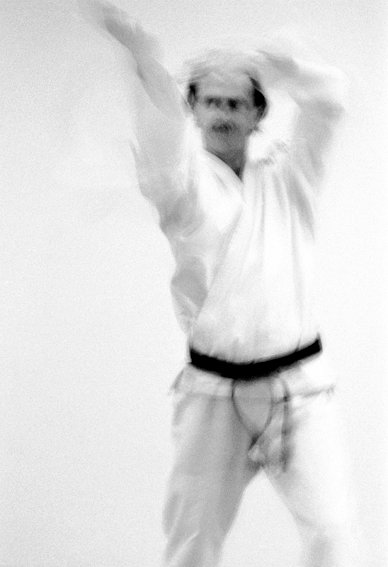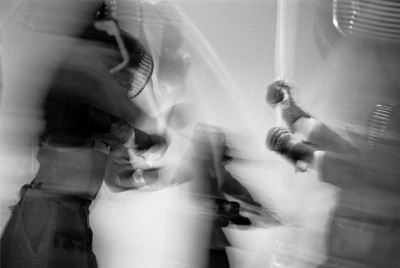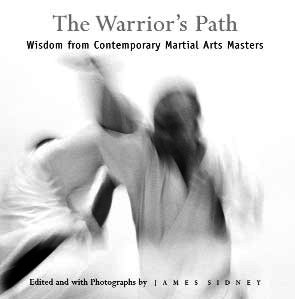SDKsupplies
Today we're speaking with James Sidney, author of the recently published The Warrior's Path: Wisdom from Contemporary Martial Arts Masters
TIJ: Tell us a bit about how you got involved in the martial arts James?
James Sidney: I started--very innocently--as a result of my father joining a traditional Shotokan karate dojo in my home town of Burlington, Ontario, when I was eight years old. My brother and sister also joined at the same time, so there was a sort of built-in support system in the family to encourage me to continue. My Dad and I were always surprising each other from out of closets like Kato and Inspector Clouseau! Seriously, I'm sure I wouldn't have continued through youth and adolescence without my father's example. He never forced me to train, but would appear very let down if I didn't come along. In the long run, I'm very grateful for that.
TIJ: What is your present situation, are you still involved in the arts?
JS: Yes, I train every week with Masami Tsuruoka sensei at his hombu dojo in Toronto. And to continue the father figure analogy, I'm also sure I wouldn't have stayed with karate-do in adulthood if not for Tsuruoka sensei's example. He's a remarkable man. A source of continual inspiration.
TIJ: Where are you teaching?
JS: I run a non-profit dojo in Milton, Ontario. We run classes four days a week and have a membership of 120 students. Two other black belts help me run the school.
TIJ: Do you do it for a living?
JS: I do draw a small salary to compensate me for the hours I put into the operation of the school--I found that once I was over the 100 student mark there was a "lot" of administration to manage. But the amount is quite inconsequential; my day job is as a photographer.
TIJ: A professional photographer! That explains the photos in the book, tell us a bit about your photography then.
JS: Actually, the photographs in The Warrior's Path are a complete departure for me. I'm a landscape photographer and have worked exclusively in colour until now. So to do a book of portraits, and in black and white, was something very different. I work with stock agencies who sell my imagery to publishers of books and magazines and calendars. I also teach seminars to photography guilds and offer photography workshops to the general public.
TIJ: Can anyone join your workshops?
JS: Yes, I'm partnered with an internet travel and leisure company, weekendtrips.com. They send me a new batch of clients every other week, which is nice, since I'm free to work on improving the workshop experience, and not generating leads. I've had hundreds of students over the last five years, it's a very rewarding adjunct to my business.
TIJ: Have you ever combined your photography and your martial arts before?
JS: When I first began making pictures, back when I was 16, I experimented with some long exposure images one evening at the dojo. In fact, the image on page 26 was taken that night. It's of my father, who now lives in Australia, and whom I haven't seen in ten years. The image was slipped in very purposefully, as a gesture to his involvement in my life in the martial arts. But other than that one night, no, never.

TIJ: Let's get back to the book, how did you get the idea for it?
JS: The book really grew out of my relationship with Tsuruoka sensei. As a long time student of his, I know how the people around him hang on his every word. They deeply respect his life experiences, and want to learn everything they can from him--while they can. I thought to myself that a collection of people like Tsuruoka sensei, representing different arts, and from all around the world would make a very satisfying and interesting project. Particularly because his generation happen to be the generation responsible for the globalization of Japanese martial arts following the end of World War II. There will never be a generation of martial artists so pioneering. Sadly, they are all approaching the final stages of life--the poignancy of which only lended more appeal to the idea for me.
TIJ: Was it difficult to contact the sensei?
JS: Yes and no. Some I had very direct contact with through my association with Tsuruoka sensei, so approaching them was relatively easy. And once I interviewed the masters, I would ask them for recommendations for other possible candidates. I did also get very lucky in Japan. Koya Shishime, the vice-secretariat of the All Japan Kyudo Federation had called Tsuruoka sensei to verify my request for an interview with the tenth dan president of the association, Nobuyuki Kamogawa sensei. Tsuruoka sensei confirmed who I was and what my intentions were, and asked Mr. Shishime to take care of me--which he did! Not only was I invited to his home, taken sight-seeing by his family, and had my travel arrangements taken care of, but he also sat down in his office with me and asked me who else I was hoping to interview in Japan. I had only one other interview lined up, with Toshiro Daigo sensei, at the Kodokan. So Shishime-san made phone calls on my behalf all afternoon, introducing me and arranging dates for me to return to Japan to finish my project. He did in one afternoon what would have taken me months on my own. Without his help, I honestly don't know how I would have managed.
TIJ: Were they willing to talk?
JS: Almost without exception. Once they consented to the interviews they were very willing and candid. I do remember a moment with Nishiyama sensei in Los Angeles, though. We were talking about him reaching the end of his career--essentially the end of his life--and when I pressed him for what that meant to him, he refused to answer. He sat very still for a while, then shook his head and said, "Next question, please." Which of course, I respected. Yoshimitsu Takeyasu, the president of the All Japan Kendo Federation, was also quite protected--but by his handlers. They were rather wary of me, and took some persuading from my interpreter before they consented to the interview. But in the end all went well.
TIJ: How did you choose the sensei to interview?
JS: What the publisher and I knew from the outset, was that we didn't want to create anything that remotely resembled a martial arts encyclopaedia. So although we wanted to collect interviews from a spectrum of modern Japanese martial arts, we didn't feel compelled to include them all. Because if we went down that road, we would then have to choose which style of each art, then which particular representative, then which...the sub-classifications would never end. Much more important to us, were the stories of these people. Some are past champions, some have historically significant family lineages, some fought in the war, some trained with the originators of their arts...that was the real draw. The experiences of the masters, not their resumes. Besides, we didn't want to create a book that suggested that the people included in it were somehow the "best", the most decorated, or most important. At the level these people are at, those are ridiculous ideas. The book needed to have a very organic feel, to reflect the richness of the masters' lives...so the process of finding the masters itself had its own sense of serendipity. I simply followed the line of connections that unfolded.
TIJ: You only interviewed gendai budo sensei, why was that?
JS: The book still needed some structure. First off, my own experience has been in the world of gendai budo--and of course, I wanted to include my own teacher, as he was the inspiration behind it. Secondly, the book has a decidedly philosophic feel, not technical, in the hopes that practitioners of judo can appreciate what the naginata sensei discuss, and vice versa. Koryu tends "more explicitly" towards combat, and gendai budo tends "more explicitly" toward character building--which fit the philosophic context. Of course, we also needed a substantial market to make the book viable, which modern disciplines have.
TIJ: How long did the process of making the book take?
JS: Three years.
TIJ: That long? Was it just because of the traveling you had to do to go interview the sensei?
JS: Finding the sensei and organizing the trips certainly was part of the delay. I travelled to Toronto, Ottawa, Seattle, Tacoma, San Francisco, London, Paris and twice to Tokyo. Early on though, the publisher tried to find some sponsorship (which nearly happened, but eventually didn't) to pay my expenses. Anyway, the search for funds really slowed us down. Finally the publisher told me it was now or never, so I went out of my own pocket.
TIJ: Who was your favourite interview?
JS: There were a lot of memorable moments. I think of the private demonstration I was given by Kamogawa sensei at the Meiji-Jingu kyudo dojo in Tokyo. It is an enormous, multi-million dollar cypress facility. Amazingly beautiful. The interview was conducted by Kamogawa sensei in kimono--which is very formal. His handlers urged me to ask for a private demonstration, as Kamogawa sensei wanted to perform for me. It was a terrific honour, and unforgettable to watch.
But I was also at the Kodokan for the Kagami Biraki celebrations, and witnessed Japan's judo elites perform. Keiko Fukuda in Los Angeles was an amazingly dear woman, and Rod Nobuto's self-effacement was unlike anyone else. There was also the interview in Suzuki sensei's home in London, with the Aiki-kai's British representative, Kanetsuka sensei, sitting at his feet, interjecting with questions. Truly, I could write a whole other book on my personal experiences--which aren't included in The Warrior's Path.
TIJ: Any other stories you'd like to share about the interviews or the traveling?
JS: I really wouldn't know where to begin...certainly staying with Murosako sensei in Seattle was memorable. I exchanged letters with him for a year, and developed an impression of him as a very stern and unforgiving man. Then, as it turned out I met him at the moment--the precise moment actually--that my case opened up on the Seattle airport luggage belt. "So you're the one," he said. Despite that start, he turned out to be an incredibly warm and gracious man (albeit with a deadly yoko-men). Still, at the moment, I was wondering what I was in for!

TIJ: Did you get a chance to practice with any of the sensei?
JS: Many of them performed for me, but I didn't do any real training, I was very concerned about getting the work done. In some instances I had only one hour to shoot a whole chapter of the book. I did spend some time trading techniques with Kosaku Tanaka sensei, in the private dojo of Shigeru Uchiyama, the oldest living exponent of Shorinji Kempo, while we were awaiting Uchiyama's arrival and eventual demonstration. But other than that, I had to focus on the task at hand--although I can tell you there were many times I wished I could have gotten on the floor!
TIJ: Is this your first book?
JS: No, I published "Images of Our Inheritance: A Journey Through Canada's Endangered Landscapes" in 1999 with my partner Sarah Stewart.
TIJ: Tell us about that book, is it still in print?
JS: Yes, it's still available. Sarah and I travelled for nine months to unprotected and threatened landscapes all across Canada. It was an amazing adventure. We met with researchers and academics, school children, activists, artists--it really was a once in a lifetime opportunity. The foreword of the book was contributed by Freeman Patterson, who was instrumental in the project. He is Canada's most respected and famous photographer--and he's also now a personal friend, I am honoured to say.
TIJ: What are your plans now? Will you do another book like this with the next generation of sensei or perhaps one on the koryu budo?
JS: Truthfully, I don't think I'll be doing another martial arts oriented book for a while. The Warrior's Path was really an unrepeatable experience for me...anything else would pale next to it. But also, to be very frank, it was a deeply challenging book to work on, and I would need to have a lot of energy behind another attempt--or a volume two!
At the moment, I'm branching my new found interest in black and white into my landscape work, which has also become very abstracted. I've got an environmental book to write next, one that's been trying to push it's way out for almost six years now. But after that? Who knows.
TIJ: Many thanks for talking with us today and best of luck with the new book.

Book Review : The Warrior's Path" Trade Paperback, 176 pages
Author : James Sidney
Canadian Publisher: Key
Porter 2003 $29.95 ISBN : 1-55263-478-7
USA Publisher: Shambhala
2003 $18.95 ISBN: 1-59030-074-2